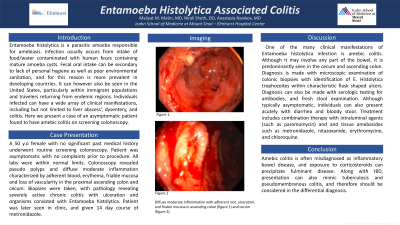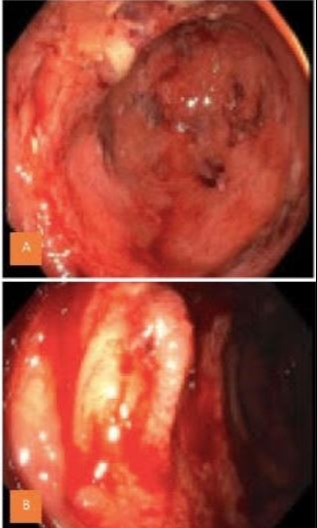Tuesday Poster Session
Category: Colon
P3058 - Entamoeba Histolytica Associated Colitis
Tuesday, October 24, 2023
10:30 AM - 4:00 PM PT
Location: Exhibit Hall

Has Audio

Maliyat M. Matin, MD
Icahn School of Medicine Mount Sinai - Elmhurst Hospital Center
Elmhurst, New York
Presenting Author(s)
Maliyat M. Matin, MD1, Nirali Sheth, DO2, Anastasia Novikov, MD3
1Icahn School of Medicine Mount Sinai - Elmhurst Hospital Center, Elmhurst, NY; 2Icahn School of Medicine Mount Sinai - Elmhurst Hospital Center, Rego Park, NY; 3Elmhurst Hospital Center/ Icahn School of Medicine at Mount Sinai, Elmhurst, NY
Introduction: Entamoeba histolytica is a parasitic amoeba responsible for amebiasis. Infection usually occurs from intake of food/water contaminated with human feces containing mature amoeba cysts. Fecal oral intake can be secondary to lack of personal hygiene as well as poor environmental sanitation, and for this reason is more prevalent in developing countries. It can however also be seen in the United States, particularly within immigrant populations and travelers returning from endemic regions. Individuals infected can have a wide array of clinical manifestations, including but not limited to liver abscess’, dysentery, and colitis. Here we present a case of an asymptomatic patient found to have amebic colitis on screening colonoscopy.
Case Description/Methods: A 50 y.o female with no significant past medical history underwent routine screening colonoscopy. Patient was asymptomatic with no complaints prior to procedure. All labs were within normal limits. Colonoscopy revealed pseudo polyps and diffuse moderate inflammation characterized by adherent blood, erythema, friable mucosa and loss of vascularity in the proximal ascending colon and cecum. Biopsies were taken, with pathology revealing severely active chronic colitis with ulceration and organisms consisted with Entamoeba histolytica. Patient was later seen in clinic, and given 14 day course of metronidazole.
Discussion: One of the many clinical manifestations of Entamoeba histolytica infection is amebic colitis. Although it may involve any part of the bowel, it is predominantly seen in the cecum and ascending colon. Diagnosis is made with microscopic examination of colonic biopsies with identification of E. Histolytica trophozoites within characteristic flask shaped ulcers. Diagnosis can also be made with serologic testing for antibodies, and fresh stool examination. Although typically asymptomatic, individuals can also present acutely with diarrhea and bloody stool. Treatment includes combination therapy with intraluminal agents (such as paromomycin) and and tissue amebacides such as metronidazole, nitazoxanide, erythromycine, and chloroquine. Amebic colitis is often misdiagnosed as inflammatory bowel disease, and exposure to corticosteroids can precipitate fulminant disease. Along with IBD, presentation can also mimic tuberculosis and pseudomembranous colitis, and therefore should be considered in the differential diagnosis.

Disclosures:
Maliyat M. Matin, MD1, Nirali Sheth, DO2, Anastasia Novikov, MD3. P3058 - Entamoeba Histolytica Associated Colitis, ACG 2023 Annual Scientific Meeting Abstracts. Vancouver, BC, Canada: American College of Gastroenterology.
1Icahn School of Medicine Mount Sinai - Elmhurst Hospital Center, Elmhurst, NY; 2Icahn School of Medicine Mount Sinai - Elmhurst Hospital Center, Rego Park, NY; 3Elmhurst Hospital Center/ Icahn School of Medicine at Mount Sinai, Elmhurst, NY
Introduction: Entamoeba histolytica is a parasitic amoeba responsible for amebiasis. Infection usually occurs from intake of food/water contaminated with human feces containing mature amoeba cysts. Fecal oral intake can be secondary to lack of personal hygiene as well as poor environmental sanitation, and for this reason is more prevalent in developing countries. It can however also be seen in the United States, particularly within immigrant populations and travelers returning from endemic regions. Individuals infected can have a wide array of clinical manifestations, including but not limited to liver abscess’, dysentery, and colitis. Here we present a case of an asymptomatic patient found to have amebic colitis on screening colonoscopy.
Case Description/Methods: A 50 y.o female with no significant past medical history underwent routine screening colonoscopy. Patient was asymptomatic with no complaints prior to procedure. All labs were within normal limits. Colonoscopy revealed pseudo polyps and diffuse moderate inflammation characterized by adherent blood, erythema, friable mucosa and loss of vascularity in the proximal ascending colon and cecum. Biopsies were taken, with pathology revealing severely active chronic colitis with ulceration and organisms consisted with Entamoeba histolytica. Patient was later seen in clinic, and given 14 day course of metronidazole.
Discussion: One of the many clinical manifestations of Entamoeba histolytica infection is amebic colitis. Although it may involve any part of the bowel, it is predominantly seen in the cecum and ascending colon. Diagnosis is made with microscopic examination of colonic biopsies with identification of E. Histolytica trophozoites within characteristic flask shaped ulcers. Diagnosis can also be made with serologic testing for antibodies, and fresh stool examination. Although typically asymptomatic, individuals can also present acutely with diarrhea and bloody stool. Treatment includes combination therapy with intraluminal agents (such as paromomycin) and and tissue amebacides such as metronidazole, nitazoxanide, erythromycine, and chloroquine. Amebic colitis is often misdiagnosed as inflammatory bowel disease, and exposure to corticosteroids can precipitate fulminant disease. Along with IBD, presentation can also mimic tuberculosis and pseudomembranous colitis, and therefore should be considered in the differential diagnosis.

Figure: Diffuse moderate inflammation with adherent clot, ulceration, and friable mucosa in Ascending colon and cecum
Disclosures:
Maliyat Matin indicated no relevant financial relationships.
Nirali Sheth indicated no relevant financial relationships.
Anastasia Novikov indicated no relevant financial relationships.
Maliyat M. Matin, MD1, Nirali Sheth, DO2, Anastasia Novikov, MD3. P3058 - Entamoeba Histolytica Associated Colitis, ACG 2023 Annual Scientific Meeting Abstracts. Vancouver, BC, Canada: American College of Gastroenterology.
